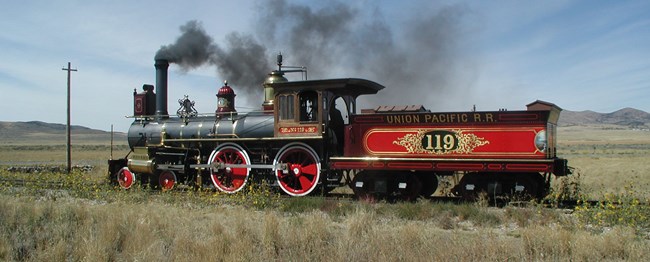
NPS Photo
Jupiter Heads West In September 1868, Schenectady Locomotive Works of New York built Central Pacific locomotives Storm, Whirlwind, Leviathan, and Jupiter. Like all Central Pacific locomotives built until 1870, they were dismantled from their frames, loaded onto a ship, and taken around South America’s Cape Horn to San Francisco, California. At San Francisco, the engines were loaded onto a barge and towed upriver to Central Pacific headquarters in Sacramento. There, they were reassembled and commissioned into service on March 20, 1869. Less than two months later, Jupiter pulled Central Pacific’s President, Leland Stanford’s, special train to Promontory Summit, Utah Territory, for the Golden Spike Ceremony.
An Accidental Place in History Stanford did not originally choose Jupiter to pull his special train to Promontory. The honor of pulling Stanford’s special train first fell to the Antelope. En route to Promontory Summit, the Stanford special followed a passenger train carrying sightseers to the “wedding of the rails.” As that train passed through a large mountain cut still being cleared, workmen in the cut did not notice a small green flag flying from the locomotive. The flag indicated that another train followed close behind. Immediately after the train passed, workmen rolled a huge log down the cut. Around the corner came Stanford’s Special, and the Antelope struck the log. She wasn’t derailed, but was so badly damaged that Stanford’s telegrapher wired the next station to hold the train that was just ahead of the special. After the Special limped into the station, Stanford’s cars were coupled to the other train’s locomotive, Jupiter, who then took her place in history on May 10, 1869.
Jupiter's Final Days After her glorious moment in 1869, Jupiter continued service as a Central Pacific passenger locomotive. In 1885, Central Pacific was absorbed into the Southern Pacific Railroad system. The Jupiter name was dropped in the 1870’s when the locomotive was repainted. In 1891, her number was changed from No. 60 to No. 1195. The name change was accompanied by even greater changes such as a new boiler and new bonnet. Even her pilot, which had vertical slats, was replaced with one having horizontal slats. Then, in 1893, No. 1195 was converted into a coal burning locomotive. No longer resembling Jupiter, No. 1195 was sold later that same year to the Gila Valley, Globe, and Northern Railroad in Arizona. Being the first locomotive on their railroad, the GVG&N renamed her No. 1. There she had a loyal following and only one more change awaited “Ol’ One Spot.” The locomotive that had once been the proud Jupiter, ran on the Globe until the early 1900’s when, despite efforts of her last engineer to save her, the railroad sold their historic locomotive to scrappers. Her sale brought the railroad a scrapper’s fee of $1,000.
Union Pacific No. 119 Saves the Day During November 1868, Rogers Locomotive and Machine Works of Paterson, New Jersey, built Union Pacific locomotives No. 116, No. 117, No. 118, No. 119, and No. 120. Seven months laster, No. 119 received the call to pull Union Pacific Vice-President, Thomas Durant, and his contingent of dignitaries to Promontory Summit. Like Stanford, Durant originally chose a different locomotive to take part in the Golden Spike Ceremony. En route to Promontory for the ceremony, which was scheduled for May 8, the Durant Special was forced onto a siding and stopped at the little town of Piedmont, Wyoming, not far from the Utah border. There to greet Durant were over 400 laid off tie cutters, who had been waiting three months to be paid. Durant’s coach was immediately chained to the siding and after a delay of nearly two days, the men’s pay arrived. The delay caused Durant substantial embarrassment, cost his original locomotive her place in history, and moved the Golden Spike Ceremony to May 10.
From Rescuer to Scrap While Durant was delayed, the rain-swollen Weber River continued to rise. When the Durant Special reached the river at the Devil’s Gate Bridge, the locomotive’s engineer saw the raging water had removed some of the bridge supports. This left the bridge unsafe for the heavy engine, and the engineer refused to cross. However, after assuring Durant that the bridge would support the lighter passenger coaches, the engineer gave each coach a push with his locomotive. The cars of nervous dignitaries then coasted across the unstable structure. Unfortunately, this action left Durant without a locomotive. A hastily wired message to Ogden requested rescue. Sitting in Ogden were the five Union Pacific locomotives No. 116 through No. 120. It was the No. 119 that was next to the main line and therefore, rescued Durant’s Special and landed its place in history at the Golden Spike Ceremony. After May 10, 1869, No. 119 continued service as a freight locomotive. In 1882, she was renumbered No. 343 and served out her days until scrapped in the early 1900’s. Like Jupiter, No 119’s sacrifice brought her railroad a scrapper’s fee of $1000.
For the Love of Steam In 1975, O’Connor Engineering Laboratories of Costa Mesa, California, accepted the challenge of reproducing Jupiter and No. 119 as they were during the Golden Spike Ceremony. With no plans or blueprints, engineers and technicians set out to build the historic American 4-4-0 locomotives. Using a locomotive design engineer’s handbook from 1870 and micrometer scalings of enlarged 1869 photographs of the two locomotives, work began on building the replicas. A four year labor of love ensued, including two years just to create over 700 drawings. When the locomotives were ready, every dimension was within 1/4 inch of the original. It took four trucks to bring the gleaming replicas 800 miles here to Promontory Summit, Utah. Here, they were christened with water from the Atlantic and Pacific oceans and commissioned into service May 10, 1979, the 110th Anniversary of the Golden Spike Ceremony. 
|
Last updated: June 20, 2025
